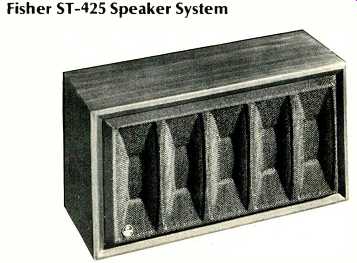
MANUFACTURER'S SPECIFICATIONS:
Frequency Response: 55-20,000 Hz.
Nominal Impedance: 6 8 ohms.
Minimum Amplifier Requirements: 15-20 watts at 8 ohms.
Woofer: 10 in.
Tweeter: 1-in. mylar dome.
Weight: 25 lbs.
Dimensions: 12 1/4 in. W x 10 in. D x 22 1/2 in. H.
Price: $89.95.
The Fisher ST-425 is a two-way loudspeaker system utilizing a 10-in. extended-range woofer, mounted in a sealed enclosure, and a 1-in. mylar-dome tweeter. The cabinet is finished on all sides in walnut vinyl and may be mounted in either a horizontal or a vertical position.
Connection to the speaker is made to well-marked terminals in a recessed cavity on the rear of the cabinet. Depressing a lever adjacent to each terminal exposes the metal opening for speaker lead insertion; releasing the lever clamps the wire firmly. The recessed panel allows for flush wall mounting without danger of shorting wires or damaging the connector. A three-position treble-control switch is also placed in the recessed panel for increasing or decreasing the tweeter response from its nominal setting. The switch positions are marked with a plus sign, zero, and a minus sign to indicate treble boost, normal, and treble cut respectively.
At 25 lbs, this enclosure may easily be placed on most any shelf without strain. But with a smooth finish on all sides, this reviewer recommends that for safety's sake either a mechanical barrier or friction mounting base be provided if the unit is mounted on a smooth shelf and cord-pulling toddlers are in the house.
A good set of instructions accompany the speakers and they give excellent guidance on setup and adjustment. An amazing thing, in today's world where many manufacturers are too busy for customer relations, is a Fisher offer extended in the instructions. If you have trouble in placing the speakers for optimum sound, an invitation is extended to write Fisher's Customer Relations Department, enclosing a sketch of the room containing the installation, an indication of the furniture (including draperies) in the room, and the place where you normally sit. Fisher states that you will receive a prompt and authoritative reply concerning suggested operation.
An original owner, 5-year warranty covering parts and labor is supplied with the Fisher ST-425.
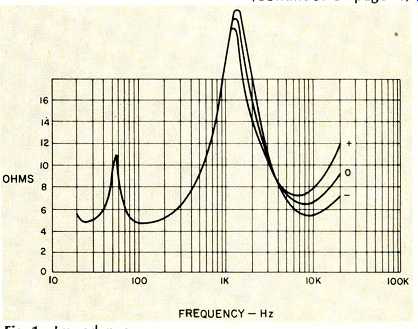
Fig. 1--Impedance.
Technical Measurements
The measured impedance of the Fisher ST-425 is shown in Fig. 1. The overall characteristic of this curve conforms to what should be expected from a two-way sealed-enclosure system. Bass impedance resonance occurs slightly below 60 Hz. The minimum impedance is just under 5 ohms. Consequently this system should be treated as though it were a 4-ohm speaker when connection is made to the power amplifier, i.e. other speakers should not be paralleled with the Fisher and reasonably heavy-gauge speaker wire should be used for hookup.
Curves are plotted for each of the three tweeter-level positions. A small amount of interaction of impedance peak with control setting is seen at around 1,300 Hz, but this is small and should not cause response difficulties.
Figure 2 shows the measured one-meter sound pressure amplitude response. Two plots are shown. The complete response, marked on-axis, is a measurement made directly in front of the enclosure. The second plot, labeled 30 degrees left, is a measurement made for an off-axis position corresponding to the Fisher used as a left channel stereo speaker. An interesting point is that the Fisher has a smoother frequency response off-axis. In making these measurements the enclosure was mounted with its longer axis vertical, in which case the instructions on the back of the enclosure are in a normal erect position. The frequency response for an off-axis position with the enclosure long axis mounted horizontally is not as smooth as with a vertical mounting, due to the wider horizontal spacing between woofer and tweeter which occurs in horizontal placement. Woofer response is smooth and free of irregularities down to 60 Hz where it rolls off smoothly, approaching an ultimate slope of 12 dB per octave.
(Editor's Note: Bass performance is essentially a series of design compromises between box size, efficiency, and the desired cutoff frequency, with several other factors playing relatively minor parts. Thus, a 60-Hz rolloff point is not unusual for a correctly aligned, closed-box system in this price class.
The response in Fig. 2 is plotted for the normal tweeter level position. Figure 3 shows the on-axis measured response for each of the three tweeter-control positions. The difference in tweeter-level settings is slight and would be noticeable only on very "bright" program material. The dip in response at around 5 kHz is due primarily to the perforated grille and is noticeable in listening tests. This is shown in Fig. 4 where measurement is made both with and without the sculptured appearance grille. It is this reviewer's opinion that, if it is cosmetically acceptable, the grille should be removed or replaced since it causes a deterioration in sound. As a point of clarification, this grille is not a foam plastic material, but a thin molded membrane with a large number of perforated openings for free sound passage.
In the measured response, the dip at 12 kHz is due to the protective perforated metal dome which is placed over the tweeter. This dome cannot, and should not, be removed.
But the re-emergence of acoustic response above 15 kHz to beyond audibility may give a "peaky" sound in some wide range material.
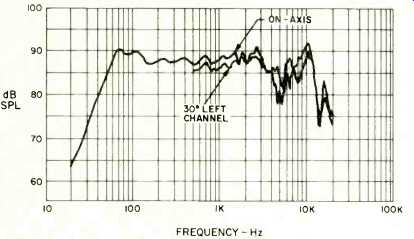
Fig. 2-One-meter anechoic SPL with one-watt drive for on-axis and 30-degree
left channel positions.

Fig. 3-One-meter anechoic SPL with one-watt drive measured on-axis with
grille on and for all three tweeter level positions.

Fig. 4-One-meter on-axis response with and without grille.

Fig. 5-One-meter phase response.
Figure 5 is the measured phase response. The acoustic transition between woofer and tweeter appears to occur be tween 4 and 5 kHz, and this is also why the grille has its most noticeable affect in that range. For a direct on-axis measurement the acoustic position above 5 kHz is approximately one inch in front of the acoustic position above 5 kHz is below 4 kHz. The phase measurement is therefore shown in two segments, one corrected for the average acoustic position above 5 kHz and tied to the right-hand angle scale, and the other corrected for the average position below 4 kHz and associated with the left-hand calibration.
The phase transition is very smooth in crossover. Both woofer and tweeter are properly phased. The only substantial non-minimum phase portions of the response are around 2-4 kHz and above 11 kHz.
The three-meter room response, which corresponds more nearly with how a speaker sounds in the listening room than does the anechoic response, is shown in Fig. 6 for the on-axis and a 30-degree left channel stereo position. The curves are displaced 10 dB for clarity. The speakers were mounted with the long axis vertical and were placed against a wall one meter above a carpeted floor. Measurement was then made of the frequency response for the first 10 milli seconds of early sound. Substantial ceiling reflections were observed for this typical room configuration. The on-axis 5 kHz dip observed anechoically was present in the room response but was substantially filled up with floor and ceiling scatter. The response for stereo listening rolls off at an average slope of around 3 dB per octave above 2 kHz. This can be brought back up with a moderate treble boost with conventional tone controls. The room response coincides with the anechoic measurement in that the overall response is smoother off-axis than directly in front of the speaker. For a more accurate stereo image, the speaker should be left flat against the wall and not rotated toward the listening area.
The energy peak at around 10 kHz may tend to cause a "spitty" response if too much treble equalization is used.
Figure 7 is the horizontal polar energy response of the Fisher measured for each of the three tweeter positions. The change in average energy between positions is less than 2 dB, which means a subtle change in tonal balance. For narrow-base stereo installation the sound should be well balanced, but extremely wide angular separation should be avoided since the left channel speaker will be "hotter" than the right channel. If a very wide stereo stage is unavoidable, the speakers should be angled slightly toward the listening area.
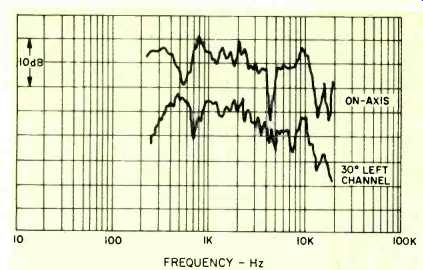
Fig. 6--Three-meter room response.
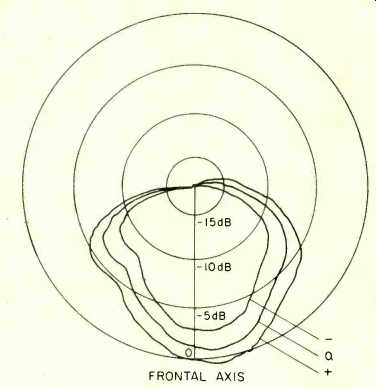
Fig. 7--Horizontal polar-energy response for three tweeter level positions.
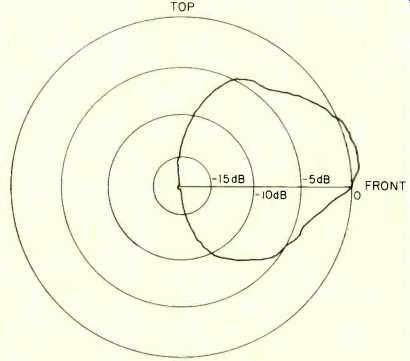
Fig. 8--Vertical polar-energy response for maximum tweeter level position.
Figure 8 is the vertical polar energy response for one of the tweeter positions. The other tweeter positions are very similar. A strong ceiling reflection can be expected for the Fisher mounted in the normal configuration with the tweeter above the woofer. If this causes an unpleasantly bright response in a room, or if the speaker must be mounted close to the ceiling, then this response indicates that the speaker should be inverted so as to launch its high frequency energy downward. While the Fisher is finished so as to be mounted either horizontally or vertically, this plot suggests that a vertical mounting is definitely preferred for better stereo imagery. In a very live room the speaker should be mounted at or slightly below a usual listening position of one meter.
Harmonic distortion for the tones E, (41 Hz), A2 (110 Hz), and A, (440 Hz) is shown in Fig. 9. Surprisingly, the lowest average distortion occurred for A2, rather than A and in fact, the A, distortion was extremely low throughout the test range. The intermodulation of A4 (440 Hz) by E, (41 Hz) is shown in Fig. 10. Frequencies higher than about 60 Hz are handled with very much lower distortion than the harmonic and intermodulation distortion measurements indicate, though distortion will occur for very low bass signals.
The nature of the IM was that of a combined amplitude and phase modulation characteristic of A4 up to about 10 watts, then the behavior assumed an amplitude modulation characteristic above that level.
The crescendo-handling properties of the Fisher ST-425 are very good. The addition of a wide-band crescendo signal at an average level 20 dB greater than a 440 Hz inner musical voice, reduces that voice by less than one tenth decibel for any total power level up to clipping on most super power amplifiers. The Fisher has a slight increase of acoustic gain with drive signal.
Figure 11 is the energy-time response measured at one meter. This is the total energy density of the sound due to a perfect impulse of electrical energy applied to the speaker terminals. The first sound from the tweeter arrives at 2.9 milliseconds on this scale and is joined within 0.08 milli seconds by the woofer signal which "fills in" the remaining 0.1 millisecond. The reverberant scatter with about a 0.2 millisecond period, due to adjacent structure including grille, rapidly drops at around 7 dB per reflection to be in significant after one millisecond. An enclosure diffraction signal one millisecond after first sound arrival is the only other significant aberration to impulse response. Transient response should be moderately good with the Fisher "as is." Removing the grille will help this response somewhat.
Listening Test
The speaker mounting position used for this evaluation was flat against a wall and centered one meter above the floor. Separation between speakers was then adjusted to give about a 60-degree total stereo angle.
The overall impression of tonal balance without equalization was that the high frequencies were good but slightly down, there was a relatively smooth but shallow-dipped upper midrange, the units had a small mid-bass bump, and the extreme low bass was missing.

Fig. 9--Harmonic distortion for the tones E, (41 Hz), A2 (110 Hz), and A4
(440 Hz).

Fig. 10--Measured intermodulation of A4 (440 Hz) by E, (41 Hz) mixed 1:1.
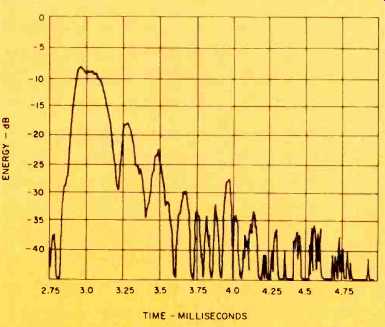
Fig. 11--Energy-time response at one meter.
The best high frequency sound, to this reviewer, was obtained with the tweeter level in its zero position and the top end lifted by pre-amp tone control. The effect of the tweeter control was slight so as to be inaudible on anything but the widest range material. The best lower frequency balance was obtained by putting in a small bass drop in the pre-amp (Marantz Model 33). While these touch-ups made low organ pedal notes a bit anemic and caused usually excel lent low bass (Percussion Music, Nonesuch H-71291) to droop, the overall balance seemed more accurate. After this touch-up of response, we got down to serious listening.
The Fisher ST-425 can handle wide-range signals at very high levels. This cleanliness of response, coupled with a relatively low efficiency, means that you are more likely to run out of amplifier than you are of running out of speaker, a situation which can cause accidental damage to the speak ers. There is a greater danger of burning out such low-efficiency speakers with a low-power amplifier than with a high-power amplifier because the low-power unit driven well into clipping will present a much higher average power to the speaker, at a given subjective loudness, than a super power amplifier capable of readily passing the peaks. Thus, if you really like your music loud, I recommend that you fuse the speaker leads with fast-acting fuses rated no larger than 2 amps. This will not only protect the woofer from overload, but will partially protect the tweeter from the heating effect of distortion fragments pushed up into its frequency range. In any case, the Fisher will need a power amplifier capable of 50 watts or more peak capability in order to get a brisk level in a moderately draped room. (Editor's Note: None of this explanation of the Fisher's ability to handle powerful, broad-band signals is meant to demean the ST-425, but rather to protect it from accidental damage in a not uncommon usage situation.) Human voice was moderately accurate, but mixed choral groups appeared to be moved back in the stereo image.
Sibilants were well articulated. The transient response of percussion instruments is excellent, though the extreme high frequencies seemed down even with treble equalization. I have never been completely pleased with the ac curacy of any loudspeaker's piano reproduction-that's why I use it for test. The subjective impression of piano on the ST-425 was a lack of body and depth, and full piano chords had an analytically accurate overtone structure, though fundamental tones appeared a bit suppressed in relative level when the speakers were equalized.
Overall stereo imagery was rather good with no requirement for the listener to sit on a calibrated chalk mark to hear good stereo, as is often the case with speakers in this low-price range.
The ability of the Fisher to be driven at high levels with out "crunch" allows for a more natural reproduction of rock, and the smooth midrange response allows for extended listening without listener fatigue. In addition, the slight natural emphasis of mid-bass material which the un-equalized Fisher gives when mounted against a wall may well prove very pleasing to those who prefer this sound in rock.
-Richard C. Heyser
(Audio magazine, Jan 1975)
Also see:
Fisher RS-Z1 Receiver (Aug. 1990)
Fisher Sound Panels (Model PL 6) (Mar. 1973)
Fairfax FX-300 Speaker System (Nov. 1972)
Frazier Concerto Model F-10W-37 speaker (Mar. 1974)
= = = =